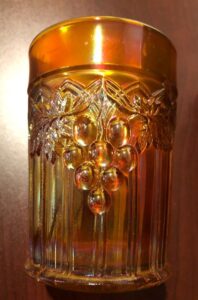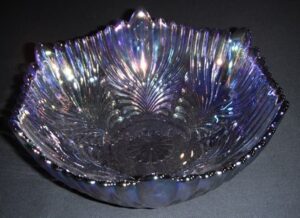Northwood Carnival Glass
Watch Dr. Lori talk about a piece of Northwood carnival glass revealing secrets as she took viewers’ questions live about it and its value.

by Dr. Lori Verderame
The history of carnival glass and Northwood carnival glass developed as pressed glass gained in popularity. Iridescent glass, the basis for carnival glass, was a type of art glass and it was modeled after the look of early Roman glass and was inspired by the late 19th Century Art Nouveau success of Louis Comfort Tiffany with the rise of favrile glass, a well known type of art glass popular with the wealthy and upper classes.
In the Roman times, iridescent glass was achieved by burying glass in areas of ground where certain chemicals were present. The resulting colorful glass had a big impact on the ancient world and when Louis Comfort Tiffany introduced his favrile glass pieces to revive early Roman glass of the 1st Century AD, similar iridescent glass options were not far behind. It is with this type of iridescent glass for the general public sold at a lower price that helped Northwood make his mark on American glass history. The commercial development of American pressed glass and iridescent glass, later called carnival glass, took place in the USA around 1900.
Northwood and the beginnings of Carnival Glass

If you are looking to learn about carnival glass, you need to know about Northwood and its impact on the designs, colors, and market influence on the history of carnival glass. Harry Northwood was the son of a famous English glass designer who moved to America and established glass factories here. He produced and was best known for brilliant carnival glass pieces in various patterns made from circa 1908-1925. When it came to the most popular products for Northwood, carnival glass led the parade. Carnival glass brought widespread acclaim to the company.
Northwood emigrated to the United States with his cousin, Thomas Dugan in 1881 and then established Northwood Glass Company in Martin’s Ferry, OH. He moved the operation to Ellwood, PA and later to Indiana, PA. Harry joined the national glass conglomerate in 1899 which changed the trajectory of the firm. After some time, Harry along with his brother Carl moved the firm, after some financial struggles, to Wheeling, WV with the encouragement of the locals as they knew that a Northwood glass factory in their town would serve the local community well.
Carnival glass and some of its most famous patterns and colors were the work of Northwood. For instance, Northwood introduced custard glass which would become well known to the general public. He also taught one student who went on to international fame in the realm of glass making, Frank Fenton of Fenton glass manufacturing. Fenton was known for his work with iridescent glass. He was a master at iridizing glass which meant he would take a hot piece of pressed glass and spray it with metallic salts to give it a colorful shimmer.
Known as the poor man’s Tiffany glass (referencing Tiffany’s famous favrile glass), Northwood and Fenton were known for carnival glass and iridescent glass respectively. Frank Fenton, from his Fenton Glass Company location in Williamston, WV introduced iridescent wares and sold them with success to the general public starting in 1907. Fenton was known as the father of iridescent glass but it was with Northwood that Fenton got his start.

Carnival glass patterns and colors
Northwood introduced iridescent glass patterns and colors including the marigold color, first known as Golden Iris.
Early and mid career Northwood patterns were the Cherry and Cable (today this is one of the most scarce and sought after patterns in all of the Northwood glass patterns), Corn, Feathers, Grape and Cable, Three fruits, Wishbone, Waterlily and Cattails, etc. While the colors were delightful and the patterns interesting, the general public understood how cheaply glass can be made and did not want to spend too much on a piece of colorful glass so these pieces became associated with giveaways at carnivals, movies, grocery stores, and as advertising gimmicks.
Carnival glass got its name from the way that it was consumed by the general public in the early 1900s. Carnival glass was not a name that was often used in the early years of the glass production. Actually collectors in the early to mid 1900s coined the term as it was a regular give away at world’s fairs, carnivals, and festivals.
Other glass companies in addition to Northwood and Fenton got into the carnival glass game like Dugan Glass Company, Millerburg Glass Company and the Imperial Glass Company in the first decade or so of the 1900s.
Northwood introduced Golden Iris as it was called which later became well known as the marigold glass color. After marigold, Northwood introduced more iridescent colors, Florentine and Pomona. Later, Northwood ushered in colors named Azure, Emerald, and Pearl in its carnival glass line. In circa 1908-09, Northwood introduced colors known as amethyst, cobalt blue, and green glass. By 1912, Northwood introduced pastel, ice blue, ice green and white carnival glass to its long list of innovative glass offerings for American consumers.Some say that Northwood is best known by collectors for its aqua opalescent glass which was introduced about the same time but its carnival glass offerings are of interest to many collectors and connoisseurs of glass searching estate sales, flea markets, and antique malls today for Northwood collectible glassware.
While Northwood introduced marigold iridescent carnival art glass, it was Fenton, at his Fenton glass company who had the original formula for carnival glass. He was the one who introduced red iridescent glass. This was a major accomplishment. Some might say the student surpassed the teacher with this move.
While colors attracted many consumers to Northwood glass and specifically to the firm’s line of iridescent carnival glass, the patterns were important too. In 1910, the Northwood firm’s best known pattern, Grape and Cable, was introduced. It was so popular that it was produced by Northwood in many of the firm’s fine iridescent colors and also in more than 60 different utilitarian shapes—tumblers, pitchers, plates, bowls, etc. Grapes would continue to have an important place in the history of Northwood patterns.
The death of the two Northwood brothers, Carl in 1918 and Harry in 1919 sparked the decline of the company and by 1925, the firm ceased operations for good. But from the late 19th Century to the end of the first quarter of the 20th Century, Northwood was a well-known name in the realm of American glassmaking.
What to Look For
Northwood script signature on glass was used by the firm starting circa 1899 at the company’s Indiana, PA location near Pittsburgh, PA. Various firms reproduced pieces of Northwood glass in their popular patterns but few retain the Northwood script signature or the best known emblem of the firm, the underlined N in a circle found at the bottom of their glass wares. So, if you see this signature on a piece of glass, get it into your collection fast.
Another Northwood mark is the highly recognizable N mark with an underline. This mark was used starting in 1905-06 at Northwood’s plant in Wheeling, WV. It was used from circa 1905 until 1916 on various patterns. Neither of these marks were registered by Harry Northwood, according to scholars. The American Carnival Glass Association holds the rights to the Northwood mark today.
Knowing where to look for a maker’s mark on a piece of Northwood glass is as important as knowing what to look for when it comes to Northwood carnival glass. For instance, on Northwood tumblers that have the underlined N in a circle, it will be found on the inside of the bottom of the glass and not on the outside of the bottom of the glass, which I call the underside. On many pieces of true authentic Northwood glass in various shapes, sizes, forms, and patterns, you can find the encircled N mark on either the inside or the outside of the underside of a piece of carnival glass.
Either way you still will have the real deal, a fine piece of Northwood carnival glass. And, interestingly enough, some pieces of carnival glass by Northwood do not have a mark at all. And, they are still correct too. The tumblers were widely reproduced by other firms that copied Northwood and they are some of the most sought after pieces in the history of Northwood and of American carnival glass.
L.G. Wright, Westmoreland, Summit Art Glass Company, and Fenton are some of the other companies that reproduced some of Northwood’s more popular patterns. Fenton had the closest association to Northwood since the owners of both firms worked together in their early career.
If you are looking to start a carnival glass collection, two good selections to get the ball rolling would be a piece of Fenton and a piece of Northwood as these pieces will offer a good mainstay to any budding carnival glass collection.
Watch videos on my YouTube channel where I show you and talk about carnival glass pieces I’ve seen and appraised. I can appraise your carnival glass from photos or you can show me your pieces during a video call.


